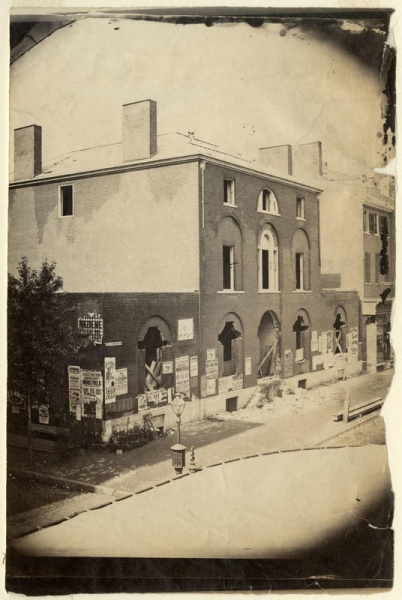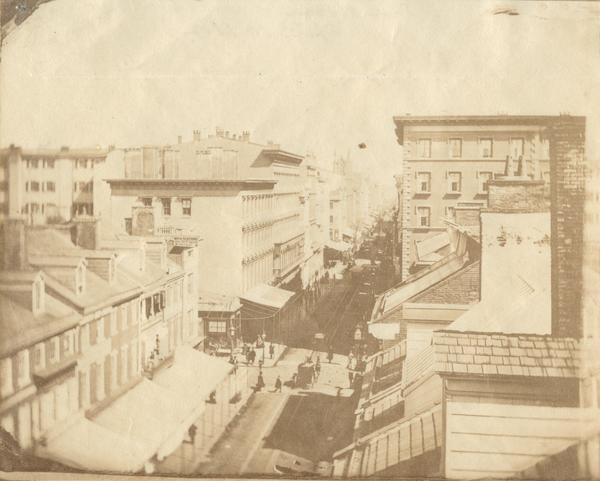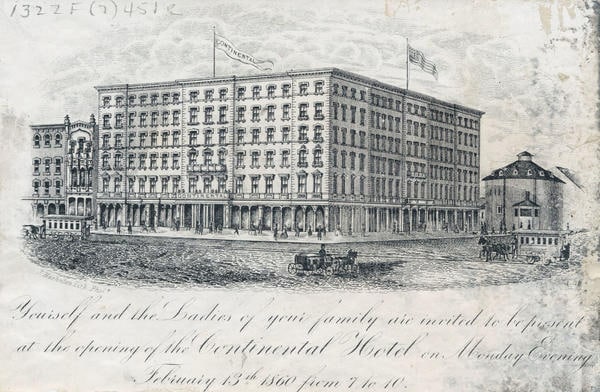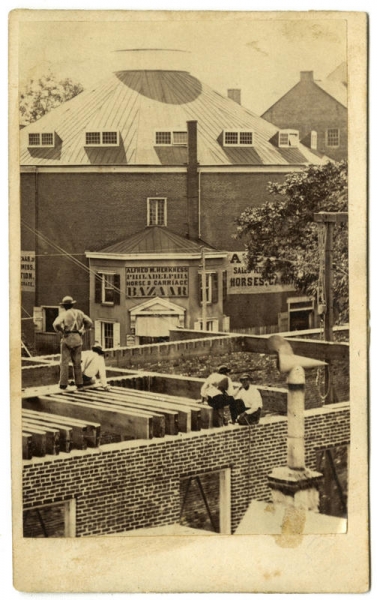Six Degrees of Separation of the Edward Shippen Burd Mansion
During this time of remote work, a few of us may occasionally find our thoughts begin to wander away from what is on our computer screen. When my mind strays, I occasionally play six degrees of separation. As the Library Company’s Curator of Graphic Arts, perhaps not surprisingly, my six degrees often correspond to visually and contextually related materials in our graphics holdings. A circa 1862 photograph of the demolition of the Edward Shippen Burd mansion prompted me to construct the below visual chain.
1ST DEGREE
Demolition of Burd Mansion, S.W. Corner Ninth and Chestnut Streets, ca. 1862. Albumen print.
When lawyer Edward Shippen Burd (1779-1848) wrote his will, he foresaw the inevitable fate of his residence. Storefronts increasingly surrounded his mansion. Following his demise and a year after the death of his wife Elizabeth, the property would be demolished. In its place “handsome stores” would be built and the income divided among Burd’s remaining heirs. Elizabeth died in 1861. The Burd Building of storefronts was erected soon thereafter.
2ND DEGREE
Henry Odiorne, Chestnut Street, Rooftop View East from Odiorne’s Studio at 920 Chestnut Street, 1860. Albumen print.
Photographer Henry Odiorne (1805-1860) captured the commercial development surrounding the Burd residence in this 1860 view from his studio. The roof of the residence, visible to the center right, is dwarfed next to the Continental Hotel to the east at 824-838 Chestnut Street. The hotel also housed several businesses, including Charles Oakford’s hat store.
3RD DEGREE
Kraemer, Charles Oakford’s 1848 & 49 Fashions for Hats, Caps & Furs, Wholesale & Retail Establishment, No. 104 Chestnut St., Philadelphia (Philadelphia: P. S. Duval, Lith. Ranstead Place, 1848). Hand-colored lithograph.
Charles Oakford (circa 1808-1862) established his own hat manufactory in 1827 at the age of twenty. By 1848, his business had outgrown three different locations, and he had assumed the wholesale trade of hats in addition to his retail business. The businessman who declared “advertising is to trade what oil is to machinery” relocated again in 1860 to the Continental Hotel.
4TH DEGREE
Invitation to the opening of the Continental Hotel (Philadelphia: J. Haehnlen Lith., 1860). Lithograph.
The Continental Hotel opened on February 13, 1860 as one of the most fashionable hotels in the city. Only a few months earlier, with the threat of a civil war looming, the shareholders agreed on the establishment’s name. “Continental” would represent the national character of Philadelphia in the spirit of our “fathers of the Republic” and “our fraternal union.” Just south of the patriotic hotel stood the Alfred M. Herkness Auction House that is visible in the right of the invitation.
5TH DEGREE
Rease, Philadelphia Horse & Carriage Bazaar (Philadelphia: Printed by F. Kuhl, ca. 1847). Lithograph.
In 1847, Alfred M. Herkness (1819-1898) occupied the building known as the “Colosseum” at the southeast corner of Ninth and Sansom Streets to operate the city’s first and only horse and carriage auction house. The building, originally built to display a 10,000-foot panorama of Jerusalem, was perfect for the creation of a track to pace the horses up for bid. During the Jersey cattle craze between 1878 and 1886, Herkness also auctioned cattle. He made nearly a million dollars in profit selling the animals to the nation’s richest entrepreneurs, including John D. Rockefeller. The auction house remained at the site until 1913.
6TH DEGREE
Broadbent & Co., Construction at Ninth and Sansom Streets, September 1862. Albumen on carte-de-visite mount.
This view captures the entranceway of the Herkness auction house south of the construction site on the former grounds of the Shippen Burd mansion. Laborers diligently work on the framework of the storefronts rising in place of the razed residence. Within the coming years, Howell & Brothers, paper hangings; J. E. Caldwell & Co., jewelers; and J. F. and E. B. Orne, carpets would tenant the Burd Building at 900-904 Chestnut Street.
Perhaps you have been inspired to search our digital catalog and create your own “six degrees of separation” image gallery. Share it on Instagram with #lcponline and #sixdegreesofseparation.
Erika Piola, Curator of Graphic Arts and Director, Visual Culture Program





![Philadelphia horse & carriage bazaar, S.E. corner of Ninth & George, between Walnut & Chesnut [sic] Sts. Philadelphia. Philadelphia horse & carriage bazaar, S.E. corner of Ninth & George, between Walnut & Chesnut [sic] Sts. Philadelphia.](https://librarycompany.org/wp-content/uploads/JPG_digitool_65312_Philadelphia-horse-carriage-bazaar-S.E.-corner-of-Ninth-George-between-Walnut-Chesnut-sic-Sts.-Philadelphia..jpg)


